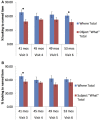Investigating the Grammatical and Pragmatic Origins of Wh-Questions in Children with Autism Spectrum Disorders
- PMID: 28344564
- PMCID: PMC5344911
- DOI: 10.3389/fpsyg.2017.00319
Investigating the Grammatical and Pragmatic Origins of Wh-Questions in Children with Autism Spectrum Disorders
Abstract
Compared to typically developing children, children with autism (ASD) show delayed production of wh-questions. It is currently controversial the degree to which such deficits derive from social-pragmatic requirements and/or because these are complex grammatical structures. The current study employed the intermodal preferential looking (IPL) paradigm, which reduces social-pragmatic demands. The IPL paradigm can help distinguish these proposals, as successful comprehension promotes the "pragmatics-origins" argument whereas comprehension difficulties would implicate a "grammatical-origins" argument. Additionally, we tested both the linguistic and social explanations by assessing the contributions of children's early grammatical knowledge (i.e., SVO word order) and their social-pragmatic scores on the Vineland to their later wh-question comprehension. Fourteen children with ASD and 17 TD children, matched on language level, were visited in their homes at 4-month intervals. Comprehension of wh-questions and SVO word order were tested via IPL: the wh-question video showed a costumed horse and bird serving as agents or patients of familiar transitive actions. During the test trials, they were displayed side by side with directing audios (e.g., "What did the horse tickle?", "What hugged the bird?", "Where is the horse/bird?"). Children's eye movements were coded offline; the DV was their percent looking to the named item during test. To show comprehension, children should look longer at the named item during a where-question than during a subject-wh or object-wh question. Results indicated that TD children comprehended both subject and object wh-questions at 32 months of age. Comprehension of object-wh questions emerged chronologically later in children with ASD compared to their TD peers, but at similar levels of language. Moreover, performance on word order and social-pragmatic scores independently predicted both groups' later performance on wh-question comprehension. Our findings indicate that both grammar and social-pragmatics are implicated in the comprehension of wh-questions. The "grammatical-origins" argument is supported because the ASD group did not reveal earlier and stable comprehension of wh-questions; furthermore, their performance on SVO word order predicted their later success in linguistic processing of wh-questions. The "pragmatic-origins" argument is also supported because children's earlier socialization and communication scores strongly predicted their successful performance on wh-question comprehension.
Keywords: SVO word order; comprehension; grammar; language; social-pragmatics; wh-questions.
Figures


References
-
- American Psychiatric Association (2013). Diagnostic and Statistical Manual of mental Disorders, 5th Edn. Arlington, VA: American Psychiatric Publishing.
-
- Ambridge B., Lieven E. V. M. (2011). Child Language Acquisition: Contrasting Theoretical Approaches. Cambridge: Cambridge University Press.
-
- Bloom L., Merkin S., Wootten J. (1982). “Wh”-questions: linguistic factors that contribute to the sequence of acquisition. Child Dev. 53, 1084.
-
- Brandone A., Golinkoff R., Pulverman R., Maguire M., Hirsh-Pasek K., Pruden S. (2007). Speaking for the wordless: Methods for studying the foundations of cognitive linguistics in infants, in Methods in Cognitive Linguistics, eds Gonzalez-Marquez M., Mittelberg I., Coulson S., Spivey M. (Amsterdam: John Benjamins; ), 346–366.
-
- Candan A., Kuntay A. C., Yeh Y., Cheung H., Wagner L., Naigles L. R. (2012). Language and age effects in children's processing of word order. Cogn. Dev. 27, 205–221. 10.1016/j.cogdev.2011.12.001 - DOI
LinkOut - more resources
Full Text Sources
Other Literature Sources

